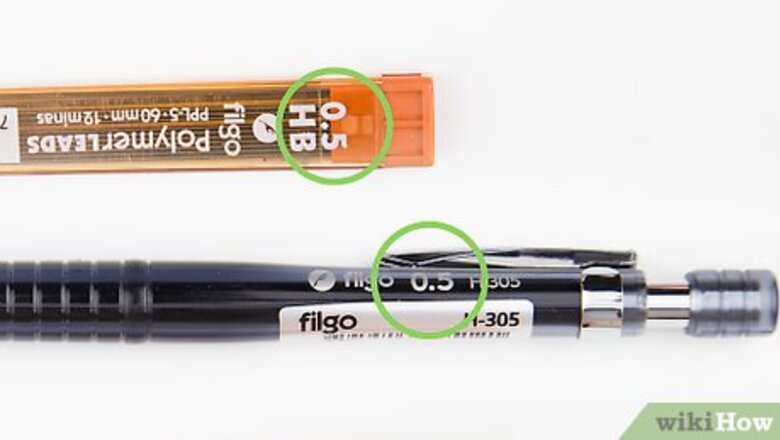
views
X
Research source
Knowing the difference between kinds of lead and the individual purpose of each will mean you won't choose the wrong lead again.
Determining the Right Lead for You
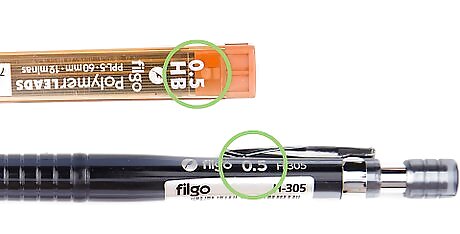
Choose the correct diameter of lead. Different mechanical pencils require lead of a certain thickness. You can usually find this measurement written either on your mechanical pencil itself or its clip. Because of how thin this lead is, the diameter is typically expressed in millimeters as a decimal, like 0.5 mm, as an example. 0.3 mm diameter is considered to be relatively thin. This size of lead might not be suitable for writing or sketching, but using it you'll be able to draw with very minute detail. 0.5 mm thick lead is used to be one of the most common sizes of lead. You might use 0.5mm lead for writing or drawing. Overall, it's still a versatile size that might be just right for your writing needs. 0.7 mm lead is a thicker variety, which makes it suited to sketching and non-detailed work. You may also find this lead useful if you do long-hand drafting. It it also more common nowadays compared to 0.5mm, as cheaper mechanical pencils became more popular using 0.7mm. 0.9 mm lead is an even thicker lead. It can be used with a rather soft lead, and therefore will have less breakage. Good for puzzles on newsprint (crossword, sudoku).
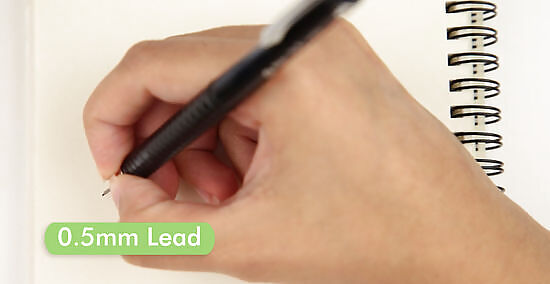
Use specialty sizes for specific purposes. Outside of .3, .5, and .7 mm lead, there are thicker and thinner sizes available for your mechanical pencil. These range from size .3 mm all the way to 5.6 mm, though sizes above .9 mm may require a specialty mechanical pencil to write with. These ultra-fine and extra thick leads are frequently intended for artists or draftsmen, though you may find that a specialty size suits your purposes as well. Some specialty leads, like sizes 2 mm and up, require sharpening, unlike most other kinds of mechanical pencil lead. You should follow the directions that come on the packaging of your lead to learn the best process for sharpening.
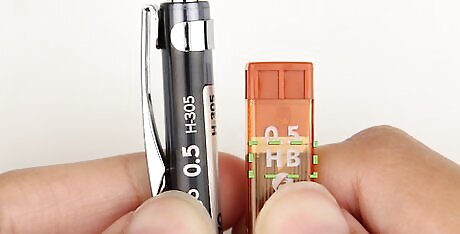
Determine the best hardness for your work. Soft lead will leave behind a thicker mark when you write. It is darker and more smudge prone than other leads. Harder leads leave behind marks that are lighter and finer. The two most common hardness ratings are medium grade HB and H leads, but there are three main categories of hardness that you should take into consideration: Soft lead. The softness of this lead is represented by a number followed by the letter B. The higher the number, the softer the lead. Therefore, 4B lead will be very soft, 3B lead less so, and so on. Medium lead. With medium leads, the letter B represents the softest kind and will write like a No. 1 pencil. HB medium leads write the same as a No. 2 pencil. F medium leads are similar to a No. 2½ pencil. Last but not least, H medium leads will be hardest and correspond to a No. 3 pencil. Hard lead. The hardness rating for hard lead is indicated by a number followed by an H. As the numbers increase, so too will the hardness of your lead. An 2H pencil (corresponding to No. 4) will be softer than a 3H pencil, and so on.
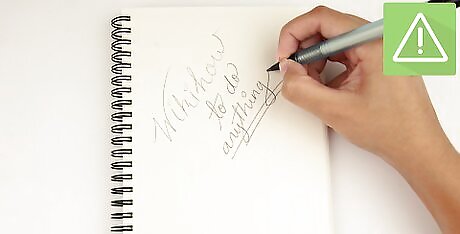
Consider your writing style. If you are aware that you have a tendency to use hard or soft pressure when writing, you should take this into account when choosing your lead hardness and thickness. The pressure you use when writing can have a distinct affect on the marks you leave on the page. Heavy handed writers may find fine points break easily when writing, while soft leads leave behind thick, clumsy looking lines. If you're one such person, you may want to stick with medium thickness leads of medium hardness or harder. Light handed writers may have difficulty with harder leads. You may find, if you have a lighter touch, that hard leads force you to press with your pencil harder than is comfortable.
Selecting the Right Mechanical Pencil

Choose the appropriate lead sleeve for your pencil. The sleeve of your mechanical pencil is the part that extends from the pen cylinder and ends where your lead emerges. There are three main varieties of sleeve for you to choose from: fixed sleeves, sliding sleeves, and sleeveless. A sleeve will give you a better view of your drawing/writing area, making this feature an asset if you do detail work in pencil. However, you should be careful when pocketing a fixed sleeve pencil; the points of these could easily jab you in the leg. Sliding sleeve pencils are able to retract within the body of your pencil. If you enjoy writing with a sleeved pencil but don't like getting poked when it's in your pocket, this option may be right for you.
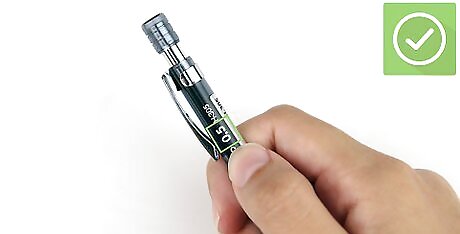
Prioritize .5/.7 mm pencils for easier lead replacement. Even if you prefer a thicker or thinner diameter lead pencil, you may want to have a .5/.7 mm on hand as well. These are the most common sizes of mechanical pencil, meaning that if you run out of lead and are in a pinch, you'll have an easier time finding or purchasing replacement lead. When using a less common sized mechanical pencil, you may want to carry replacement lead with you. This way, you won't have to scrounge for specialty lead if you run out.

Discover your preferred lead advance mechanism. A lead advance is the way in which your mechanical pencil advances lead from the hollow chamber in its barrel to the tip of the pencil. The lead advance of your pencil will be activated by a button, twist, or shake mechanism. Push button lead advances come in a two different types. Some have a button on the side of the pencil, others use a top button that combines with the eraser. In either case, you can advance your lead by pressing the button. Twist-operated lead advances were more common in older models. By twisting the barrel of your mechanical pencil, you'll cause the lead to advance. Some models may have a continuous lead advance, where the more you twist, the more lead is advanced. A shake advance can be activated by giving your mechanical a firm shake up and down. This motion will cause a small weight on the inside of the pencil to advance the lead.
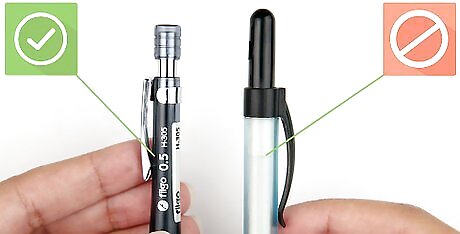
Use a pencil with a lead grade/size indicator for organization. There are some models of pencils that allow you to set an indicator to show you the grade (hardness) of the lead in your pencil. If you switch between grades when working on different projects, a grade indicator can help save you from using a pencil loaded with the wrong lead! A lead size indicator can also save you from using the wrong size of lead
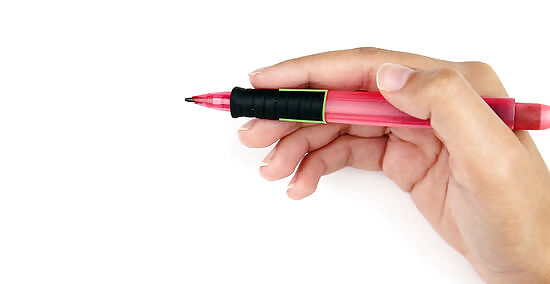
Find a pencil grip that suits your hand. Most mechanical pencils come with a padded, soft, rubber-like grip on the part your hand holds. Different pencil grips will suit different hands, and some grips have special features, like bumpy textures to help you hold onto your pencil. Take a test write with potential candidates before you make the purchase to find what feels right to you. Some pens come with a triangular shaped grip. This may feel strange to you at first, but some users appreciate the additional contact this kind of grip gives with the pencil.











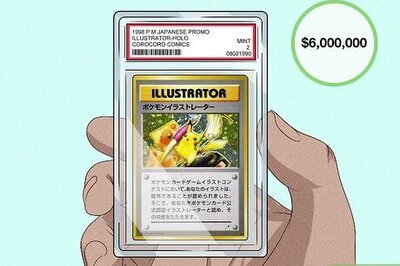







Comments
0 comment